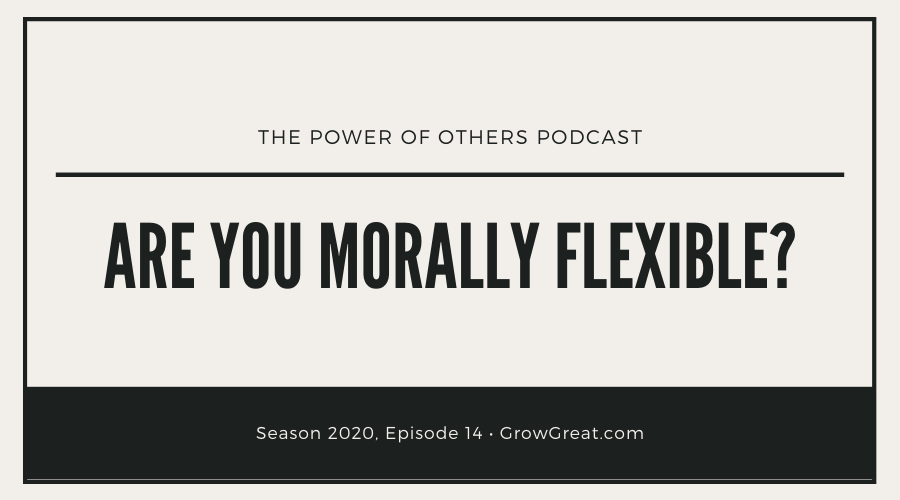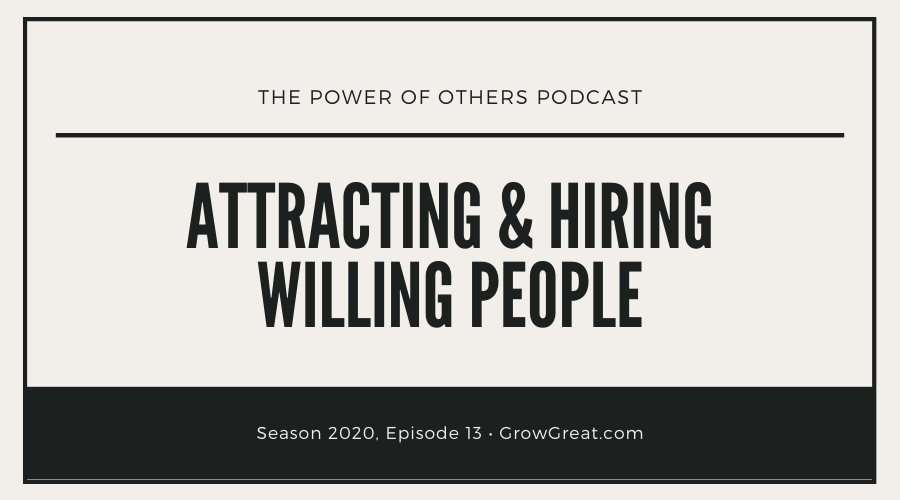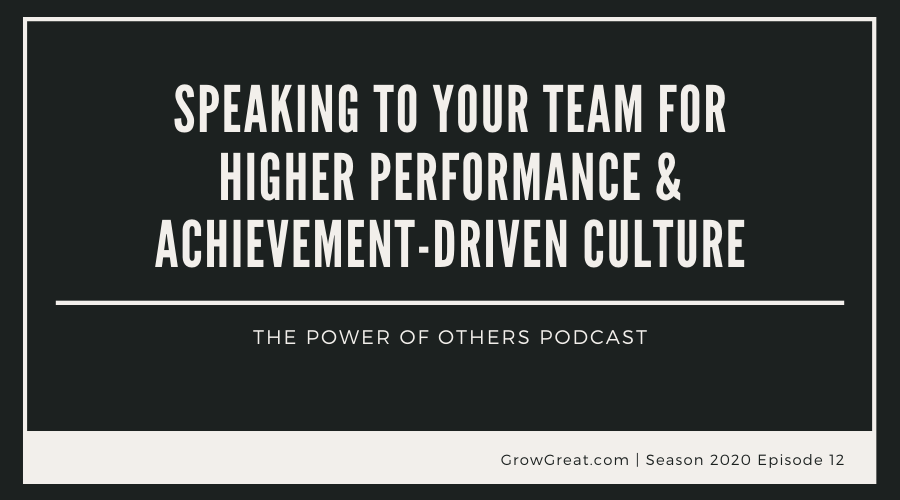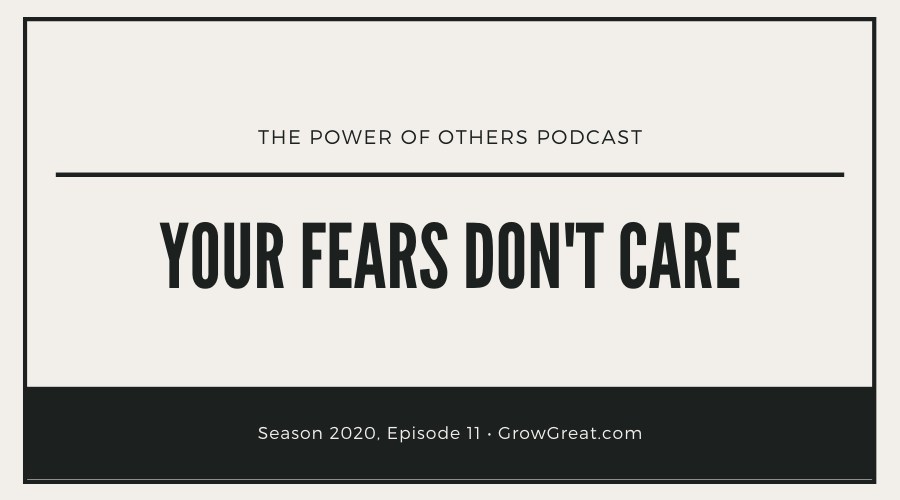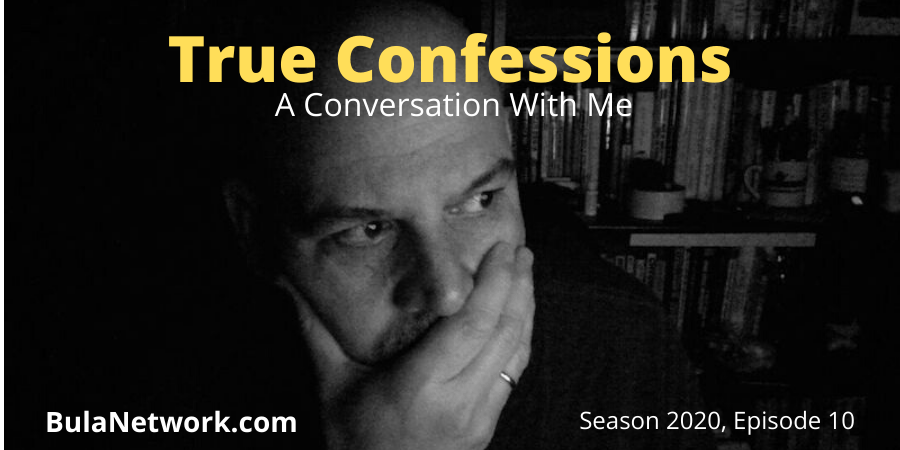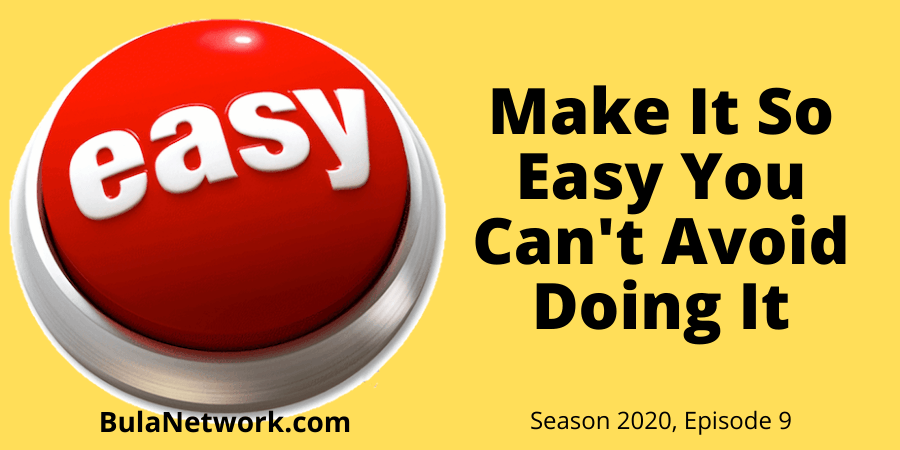Are You Morally Flexible? – Season 2020, Episode 14
Podcast: Play in new window | Download (Duration: 21:10 — 29.2MB)
Subscribe: Apple Podcasts | Spotify | RSS | More
Mike Ehrmantraut, the cleanup guy in Breaking Bad and Better Call Saul, asks soon-to-be-known as Saul Goodman attorney, Jimmy McGill…
“Are you still morally flexible?”
I’m not including the word “still” because I’m going to assume the best. That you’re morally inflexible, unwilling to do just anything for a buck. Jimmy became Saul Goodman because he was morally flexible at some point…and Mike wondered if that was still the case. Sure enough, it was. We now know how the story ends even if we are still enthralled with how it unfolds from Jimmy’s perspective. Stories of immoral, unethical and illegal behavior never end well. Never!
You ready for a TV series recommendation? Dirty Money on Netflix. It’s a series about corporation greed and corruption. The few episodes I’ve been able to watch demonstrate the pitfalls of pursuing profits no matter what. In one particular episode with a business owner who eventually suffered an enormous FTC fine and a prison sentence, the interviewer asked him, “Are you moral?” His reply, after a long pause, “I’m a businessman.”
It was offensive implying you may not be able to be one while being the other.
History has countless stories of greed and corruption. I don’t think the producers of that TV series will ever run out of great stories to tell. Unfortunately.
Cheating. Cutting corners. Skirting laws, rules, and ethics.
And it’s not just in business. It’s pervasive. Ask the Houston Astros. Ask major college programs who’ve suffered NCAA sanctions. Go ask your local youth rec league directors and I promise if they’ve been doing that work for more than 2 seasons they’ll also have stories of cheating in youth sports.
“If you’re not cheating, you’re not trying.” -Eddie Guerrero
Eddie was a wrestling Hall of Famer. No, that Olympic wrestling. Soap opera wrestling. His quote is a common sentiment though.
In spite of the books, movies, TV shows, investigative reports and whatever form the horror stories take about immoral, unethical or illegal behavior in business — greed still corrupts people. From small business owners who choose to not report income to multi-billion dollar company CEOs who choose to violate laws.
The lure? Quick. Easy. Vast.
People who are going to steal from you – whether they’re employees or shoppers – are going to figure out how. I’m not sure you can prevent it, but you can work hard to catch it. If you’re successful you can uncover it quickly to minimize the losses.
Then there are people who won’t steal from you unless they’re given an opportunity. Some will avoid stealing unless the opportunity seems irresistible. Others will steal more easily, but only if the opportunity persists. So you do your best to help keep honest people honest. You remove as many opportunities as possible. For yourself and for the people who may be tempted to misbehave.
That’s how I feel about business morality and ethics.
Scoundrels are going be scoundrels until they’re caught.
Others can be tempted to be scoundrels if the rewards are high enough, easy enough and fast enough. It’s the temptation that has resulted in poor behavior to bring down many, many business people.
What about us? What about you? What about me?
How can we safeguard ourselves and our businesses? What can we do to ensure that we’re behaving ethically, morally and legally?
It begins with character. Our character.
“The best index to a person’s character is how he treats people who can’t do him any good, and how he treats people who can’t fight back.”
– Abigail Van Buren
Our character is who we are. It’s also who we most want to be. It’s our willingness to be a better person. And it’s our determination to work toward becoming our ideal self.
“Nearly all men can stand adversity, but if you want to test a man’s character, give him power.” – Abraham Lincoln
Some have commented that our character is who we are when nobody is looking. That doesn’t just happen. We have to put in the work to make it so. That’s likely where some of our problems start. We’re not putting in the work on ourselves. Sometimes we disconnect ourselves from who we are at work. We can be tempted to think there are work rules, but those don’t have to be congruent with our personal rules. So we can more easily compromise our personal convictions because we can be fooled thinking it’s all good because it’s under the guise of business.
“Be more concerned with your character than your reputation, because your character is what you really are, while your reputation is merely what others think you are.” – John Wooden
I’m a teenager working retail. “Bait and switch” is illegal. State government agencies would pay attention to the practice. Somewhat. But I’m introduced to it when my employer runs an ad in the paper for an item we don’t have in stock, except for the floor model. I learn it’s perceived as “common practice.” I don’t know if that’s true or not, but it didn’t matter to me because I just choose to ignore it. The object of “bait and switch” was to get people to come into the store and/or get people to buy something with higher profit. Well, I knew I wasn’t in control with what brought people into the store, but I was in complete control over my interaction with the shoppers. That experience is likely what led to my ability to employ “step down” selling. Rather than show the low-end loss leader that was advertised I’d start toward the upper end, just beyond the reach of the shopper – based on what they told me they wanted to invest. And I’d honestly, candidly tell them, “You don’t want to spend this much, but I want to help you figure out what is worth paying for and what isn’t.” After reviewing that item I’d quickly step down to another item within their budget, but I wouldn’t stop there. “You may be able to save some more money and be very happy. You need to decide.” I’d show them another item that might only give up one or two features that might not matter to them. Or maybe those few features mattered a lot. I wanted the shoppers to decide that for themselves. My job, as a teenage hi-fi salesperson, was to help educate them on what was available by being as honest as I knew how to be. It’s just something I figured out and did. Nobody trained me in that art.
Treating other people the way I wanted to be treated was rule one. I wanted to just tell people the truth and let them make up their own minds. As for the door-busting “bait and switch” items, I could easily go to something that provided much higher value to the shopper. I wouldn’t make an excuse. I’d just tell the shopper that the only one we had in stock was the floor model and that would end it, but it always bothered me. I wasn’t in control of advertising or stock levels.
By the time I was responsible for advertising and stock levels (and everything else), it didn’t happen. I choose to not live like that. I choose to not make employees live like that.
I’m not noble. There are many things I’m not, but I had decided even as a kid that I wasn’t going to be dishonest. At some point, I had a thought. If my employer will rip off customers then they’ll rip me off, too. I found another job. I found more honest people to work for. And like you, probably, I found out I’d endure many more temptations to cut corners for the sake of profits. Or revenues. Or both.
Certain truths helped me along the way.
One, doing the right thing is always more profitable over the long haul. Nobody loses when you do the right thing. Especially you. The math isn’t as simple as people are tempted to think. I cut a corner and I double my profits. No, cut a corner and people inside your company know. That fosters a different kind of workforce, one willing to compromise their character just as you have. Cut a corner and now you risk people outside your company finding out. There goes your reputation and word of mouth can kill your enterprise. Cutting the corner, no matter how much money is gets you in the short-term, isn’t enough to risk your company or career.
Two, if you’re willing to do the wrong thing today you’ll be more willing to do something even more wrong tomorrow. That’s how it works. Like the addict, enough today won’t be enough tomorrow. The crime gets worse and your conscience gets calloused. Justification gets easier and easier. Delusion becomes your way of life. Deluded business people don’t last long. Never long enough to overcome their delusion.
Three, if you do the wrong thing you lose empathy and compassion. You have to in order to live with yourself. Nobody matters. Dollars do. Your loss of empathy and compassion don’t just take a toll on you professionally, they destroy you personally. Relationships falter. Your self-importance grows. Along with your greed and corruption.
Four, you think you won’t get caught, but you will. It’s only a matter of time. Bigger and brighter people thought the same thing. Until they were found out. Whether it was an early morning FBI raid on their house or a team from the IRS along with federal agents coming to seize all your records…they eventually come seeking payment for the wrong you’ve done.
Moral flexibility isn’t a virtue. It’s a character flaw at best. Willful criminal intent at worst.
Five, doing business the right way has overwhelming benefits that no corner-cutting can match.
You prove what an honorable, upright and moral business you’re determined to lead. That prompts you to attract people who want to work in that type of environment. Scoundrels need not apply.
You prove to the market how you’ll conduct business. That prompts shoppers and prospects to give you an opportunity to serve them. Everybody wants to deal with a company they can trust.
You build what I’ve come to learn is the number one asset any company can have – a rock-solid, loyal customer base. You have customers who tell everybody they know how terrific you are.
Your growth may be slower, but it will likely be steadier and more sustainable. Working daily to perform great work is a reward not merely measured in dollars. Devotion to the daily processes of building a great company is the path toward growing great in every way.
You build character along the way. And pride. Pride in accomplishing something valuable and worthwhile. To yourself. To your employees. To your customers.
Sure, right is right, but there are compelling reasons why doing the right thing makes perfect business sense. Let me leave you with a few suggestions that may help you in the quest to grow great the right way.
- Don’t have any moral flexibility at all. None. Never give an inch. Never entertain it. Just go in assuming you’ll always refrain from compromising. That’ll make it easier because you’ve determined it ahead of time.
- Coach for performance, fire for poor behavior. That doesn’t mean you shouldn’t fire for poor performance, but you should be more tolerant as you try to help a person elevate their performance. An employee who knowingly lies to a customer though – or commits some other wrong – should be fired. If you tolerate it you signal to all your employees that you’ll allow it. That’s their signal that you indeed are morally flexible. Bad signal to send…unless of course, it’s true.
- Walk the talk. Training people how to cheat customers while extolling how you’d never cheat the employees is foolish. Even more foolish…the belief that they’ll never steal from you. You’ll wind up running a den of thieves. Instead, be honest all the time. Expect honestly from others, all the time. Through thick and thin it’s the best option.
- Your biggest wins may come from losses. I think back over the years and the times when I’ve walked away from something because it was unethical or immoral or illegal…and the company found out the dollars that were at stake…it made an enormous impact on the culture for good. It shows people that you’re not just preaching a sermon, but you’re living it. When people see how much you mean it, how much it matters to you – they join the revolution with you.
If you’ve been willing to do wrong in the past for the sake of profits or anything else, then draw your line in the sand today. Better yet, etch it in stone. Stop. Make up your mind, enough. No more. Don’t con yourself into thinking everybody does it. They don’t. Don’t keep telling yourself it’s not a big deal. It is a big deal. I don’t care how much money is on the line. You’re eroding your character every time you flex. You’re diminishing your value as a person. Stop doing that so you can begin to build yourself up. Life is about fortifying yourself so you can grow and become a better version of YOU -the best version of you.
Be well. Do good. Grow great!
Randy
Are You Morally Flexible? – Season 2020, Episode 14 Read More »
